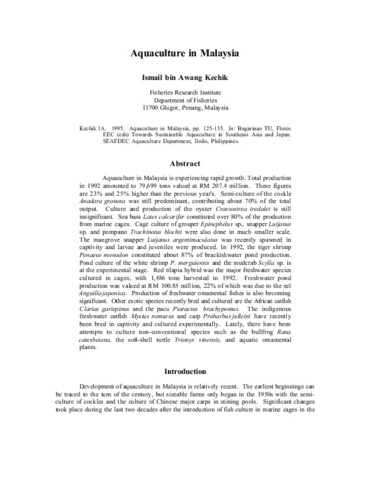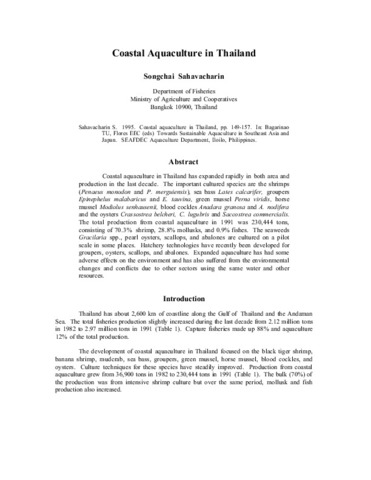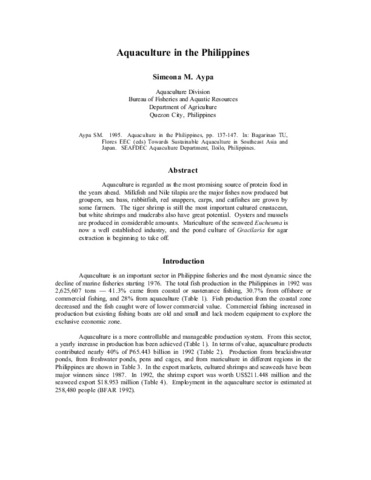| dc.contributor.author | Genodepa, Jerome G. | |
| dc.contributor.editor | Quinitio, Emilia T. | |
| dc.contributor.editor | Parado-Estepa, Fe Dolores | |
| dc.contributor.editor | Coloso, Relicardo M. | |
| dc.date.accessioned | 2017-08-25T09:01:03Z | |
| dc.date.accessioned | 2017-08-25T16:31:55Z | |
| dc.date.available | 2017-08-25T09:01:03Z | |
| dc.date.available | 2017-08-25T16:31:55Z | |
| dc.date.issued | 2017 | |
| dc.identifier.citation | Genodepa, J. G. (2017). Management strategies for grow-out culture of mud crab. In E. T. Quinitio, F. D. Parado-Estepa, & R. M. Coloso (Eds.), Philippines : In the forefront of the mud crab industry development : proceedings of the 1st National Mud Crab Congress, 16-18 November 2015, Iloilo City, Philippines (pp. 22-27). Tigbauan, Iloilo, Philippines: Aquaculture Department, Southeast Asian Fisheries Development Center. | en |
| dc.identifier.isbn | 9789719931072 | |
| dc.identifier.uri | http://hdl.handle.net/10862/3181 | |
| dc.description.abstract | There is an increasing interest in mud crab farming because of the growing demand for mud crab in domestic and international markets. Different methods for rearing crabs in ponds, pens and cages have evolved through several years of research and experiences of farmers. Mud crabs are cultured in brackishwater earthen ponds and pens in mangroves. Fattening of lean crabs is also integrated with the grow-out culture system. Cannibalism is one of the major factors affecting the survival of crabs in growout ponds and pens. Hence, various strategies are recommended to reduce cannibalism such as stocking density of less than 2,000 crabs ha-1, provision of suitable shelters, sufficient quantity of natural food and formulated feeds that are evenly distributed in the pond or pen. Feeding rate used in the pen is adjusted to avoid excess feeds that can attract rats and other land animals that can damage the enclosures. Selective harvesting is normally practiced since mud crabs do not grow or get fattened at the same time even if they belong to the same batch. | en |
| dc.language.iso | en | en |
| dc.publisher | Aquaculture Department, Southeast Asian Fisheries Development Center | en |
| dc.subject | Scylla serrata | |
| dc.subject | Philippines | en |
| dc.title | Management strategies for grow-out culture of mud crab | en |
| dc.type | Conference paper | en |
| dc.citation.spage | 22 | |
| dc.citation.epage | 27 | |
| dc.subject.asfa | aquaculture | en |
| dc.subject.asfa | brackishwater aquaculture | en |
| dc.subject.asfa | cannibalism | en |
| dc.subject.asfa | crab culture | en |
| dc.subject.asfa | feeds | en |
| dc.subject.asfa | feeding | en |
| dc.subject.asfa | growing ponds | en |
| dc.subject.asfa | harvesting | en |
| dc.subject.asfa | marine crustaceans | en |
| dc.subject.asfa | pond culture | en |
| dc.subject.asfa | stocking density | en |
| dc.subject.asfa | survival | en |
| dc.subject.asfa | trade | en |
| dc.citation.conferenceTitle | Philippines : In the forefront of the mud crab industry development : proceedings of the 1st National Mud Crab Congress, 16-18 November 2015, Iloilo City, Philippines | en |
| dc.subject.scientificName | Scylla serrata | |



